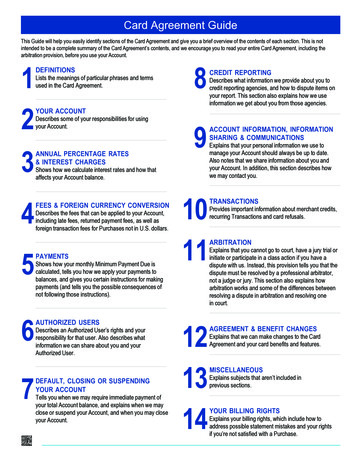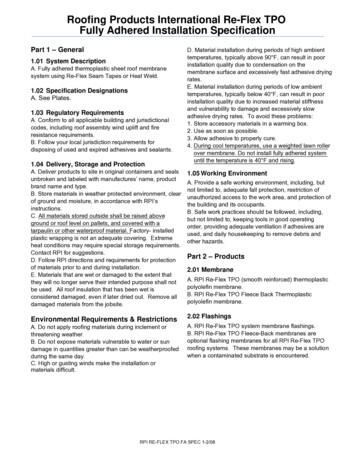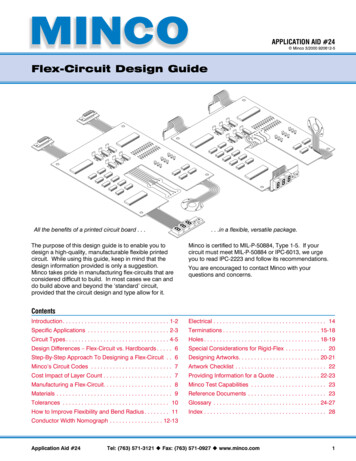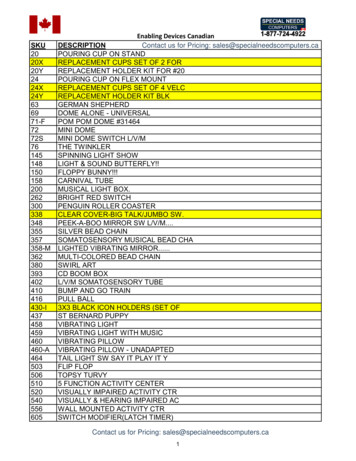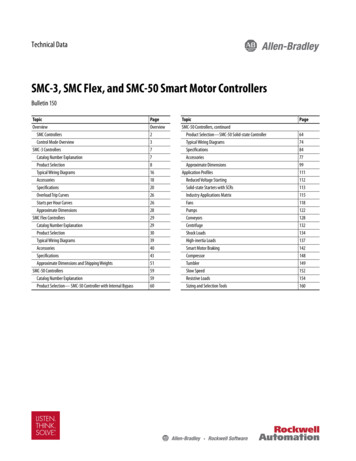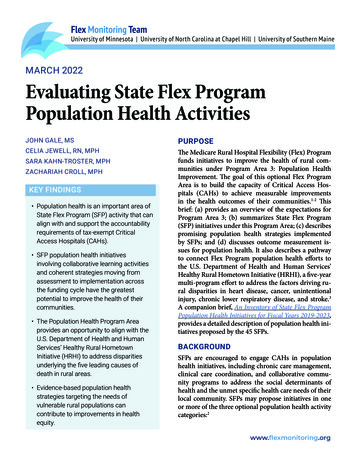
Transcription
Flex Monitoring TeamUniversity of Minnesota University of North Carolina at Chapel Hill University of Southern MaineMARCH 2022Evaluating State Flex ProgramPopulation Health ActivitiesJOHN GALE, MSPURPOSECELIA JEWELL, RN, MPHThe Medicare Rural Hospital Flexibility (Flex) Programfunds initiatives to improve the health of rural communities under Program Area 3: Population HealthImprovement. The goal of this optional Flex ProgramArea is to build the capacity of Critical Access Hospitals (CAHs) to achieve measurable improvementsin the health outcomes of their communities.1-2 Thisbrief: (a) provides an overview of the expectations forProgram Area 3; (b) summarizes State Flex Program(SFP) initiatives under this Program Area; (c) describespromising population health strategies implementedby SFPs; and (d) discusses outcome measurement issues for population health. It also describes a pathwayto connect Flex Program population health efforts tothe U.S. Department of Health and Human Services’Healthy Rural Hometown Initiative (HRHI), a five-yearmulti-program effort to address the factors driving rural disparities in heart disease, cancer, unintentionalinjury, chronic lower respiratory disease, and stroke.3A companion brief, An Inventory of State Flex ProgramPopulation Health Initiatives for Fiscal Years 2019-2023,provides a detailed description of population health initiatives proposed by the 45 SFPs.SARA KAHN-TROSTER, MPHZACHARIAH CROLL, MPHKEY FINDINGS Population health is an important area ofState Flex Program (SFP) activity that canalign with and support the accountabilityrequirements of tax-exempt CriticalAccess Hospitals (CAHs). SFP population health initiativesinvolving collaborative learning activitiesand coherent strategies moving fromassessment to implementation acrossthe funding cycle have the greatestpotential to improve the health of theircommunities. The Population Health Program Areaprovides an opportunity to align with theU.S. Department of Health and HumanServices’ Healthy Rural HometownInitiative (HRHI) to address disparitiesunderlying the five leading causes ofdeath in rural areas. Evidence-based population healthstrategies targeting the needs ofvulnerable rural populations cancontribute to improvements in healthequity.BACKGROUNDSFPs are encouraged to engage CAHs in populationhealth initiatives, including chronic care management,clinical care coordination, and collaborative community programs to address the social determinants ofhealth and the unmet specific health care needs of theirlocal community. SFPs may propose initiatives in oneor more of the three optional population health activitycategories:2www.flexmonitoring.org
Flex Monitoring TeamUniversity of Minnesota University of North Carolina at Chapel Hill University of Southern Maine3.1 Support to assist CAHs in identifying communityand resource needs includes assessment and planningresources to support CAH population health interventions under Activity Categories 3.2 and 3.3. Suggestedactivities include encouraging CAHs to complete aPopulation Health Readiness Assessment (PHRA),4using the assessment results to assist them in buildingcapacity, offering community health needs assessment(CHNA) trainings, and evaluating CAH CHNAs andimplementation plans prepared to inform planningfor population health cohorts.3.2 Assist CAHs with building strategies to prioritizeand address unmet community needs utilizes the results of PHRAs and CHNAs to help CAHs design action plans to address the needs of their communities.Tax-exempt (501(c)(3)) CAHs are required to conduct triennial CHNAs and use the results to implement strategy plans to address priority needs. Whilepublicly owned CAHs are not subject to these requirements, SFPs can encourage them to engage in population health planning and participate in CAH population health cohorts. Suggested activities includesharing resources to inform population health actionplanning; offering population health education workshops or webinars; facilitating collaboration betweenCAHs and community stakeholders; and evaluatingthe progress of action plans.3.3 Assist CAHs with engaging community and public health stakeholders to respond to the populationhealth needs of their communities. This activity category seeks to build on information collected throughCHNAs, implementation plans, and engagement between CAHs, public health leaders, and communitystakeholders to address local concerns. Suggested activities include implementing chronic care management programs; substance use prevention, treatment,and recovery strategies; mental health services; andprograms to address public health, wellness, and thesocial determinants of health.These three activity categories suggest a stepwiseprocess that can be implemented across the five-yearfunding cycle. Activity Category 3.1 includes planningand assessment activities to support development ofCAH population health initiatives (Activity Category 3.2) and implementation of targeted interventions(Activity Category 3.3). Assessment and planningwork is best accomplished early in the funding cycleto identify and build on CAH strengths, address CAHweaknesses, and quantify community needs that canbe addressed throughout the funding cycle. AlthoughSFPs are not required to implement such an approach,a comprehensive multi-year population health strategy is more likely to improve population health thanunconnected initiatives under any one or more activity categories. This brief will highlight examples ofSFPs that have adopted this multi-year approach topopulation health.APPROACHWe reviewed the FY2019 State Flex Program competitive grant applications to inventory and categorizeprojects proposed under each activity category underProgram Area 3. We also reviewed other Program Areas to identify population health-related initiatives.We further reviewed the FY2020 Non-CompetitiveContinuing applications and FY2019 End of Year reports to assess the continuation of these activities in2020, as well as identify any new or revised activities.We summarized the initiatives for each SFP and codedthem thematically to identify common activities.In conducting our initial inventory of SFP population health activities, we originally grouped each activity using the activity category under which it wasproposed. As we observed that not all SFPs reportedsimilar activities in the same activity categories, werecategorized activities to group similar activities consistently across the states.In addition to describing the specific activities proposed by each SFP, we identified the process/outputand outcome measures identified by SFPs for theirpopulation health activities. Finally, we examined theNotice of Funding Opportunity for the HRHI track ofthe Rural Health Care Services Outreach Grantpage 2
Flex Monitoring TeamUniversity of Minnesota University of North Carolina at Chapel Hill University of Southern MaineProgram to identify opportunities to align Flex Program activities conducted under Program Area 3 withthe multi-year HRHI initiative.RESULTSSummary of State Health Flex Program Population Health InitiativesDetailed information on SFP population health activities is available in the supplemental brief for thisproject, An Inventory of State Flex Program PopulationHealth Initiatives for Fiscal Years 2019 – 2023. This section provides a high-level summary of SFP populationhealth activities as described in that brief.Thirty-one SFPs implemented one or more initiativesunder Activity Category 3.1 (Figure 1) with the mostcommon focusing on supporting CAHs in completing CHNAs through trainings, technical assistance(TA), and distribution of community health data; analyzing the CHNAs or other assessments to identifyshared issues in the CAH communities and to informinitiatives for Activity Categories 3.2 and 3.3; and encouraging CAHs to take a population health readinessassessment to gauge leadership’s understanding of andthe hospital’s capacity to address population health.Twenty-four SFPs offered programming to assistCAHs with strategies to prioritize and address unmetneeds under Activity Category 3.2. When we included population health-related activities from otherprogram areas and recategorized activities to groupsimilar activities consistently across the states, wefound that 34 SFPs implemented this type of initiative(Figure 2). The most common interventions involvedtraining or TA to develop strategies to prioritize andaddress unmet needs, followed by assistance to CAHsto formalize their strategies into action plans.Twenty-seven SFPs offered programming to assistCAHs to address specific health needs under Activity Category 3.3. When we included populationhealth-related activities from other program areasand recategorized activities to group similar activitiesconsistently across the states, we found that 34 SFPsimplemented this type of initiative (Figure 3). SFPsfacilitated collaboration between CAHs and community and population health stakeholders using datasummaries and tools, educational opportunities, andengagements with local health authorities, state publichealth officers, payers, and other stakeholders. Theyaddressed a range of health needs with the most common interventions focused on health and wellness,FIGURE 1: Assisting CAHs to Identify Community Resources and Needs (n 31 SFPs)Support CHNA comple on14Iden fy collec ve issues from community assessments12Encourage readiness assessments12Maintain database of community assessments7Create and distribute community health profiles7Assess CAH popula on health training needs3Support other community needs/resource assessments3Provide community benefit assessment/training2States may use more than one approach to assist CAHs with identifying community resources and needs.page 3
Flex Monitoring TeamUniversity of Minnesota University of North Carolina at Chapel Hill University of Southern Mainebehavioral health, chronic disease management, andthe social determinants of health (Figure 3). Nine ofthe 34 SFPs waited to determine what specific healthneeds to focus on until after they had worked withtheir CAHs to assess need and determine priorities.Promising SFP Population Health StrategiesIn reviewing the inventory of SFP population healthactivities, we observed that SFPs proposed a wide variety of population health activities across the threeactivity categories. Many focused on providing basiceducation, technical assistance, and support relatedto the CHNA process and/or population health readiness assessments. While these activities may be useful to some CAHs, they do not necessarily represent acomprehensive strategy to assist CAHs in implementing evidence-based population health initiatives. It isalso difficult to link these activities to demonstrableimprovements in population health.Based on our inventory review, we identified twopromising approaches to supporting populationhealth. The first involves engaging CAHs in collaborative learning cohorts focused on addressing commonly identified population health issues. The secondinvolves implementing coordinated strategies acrossthe funding cycle to improve population health.Minnesota and Colorado provide examples of cohort-based collaborative learning initiatives. Although Arizona’s activities are not cohort-based, SFPstaff follow a sequential approach to working withtheir CAHs on population health initiatives across activity categories and the funding cycle.Minnesota developed two cohort-based initiatives thatdraw on the population health readiness assessmentscompleted by CAHs in Year One. The first initiativeis based on Rural Health Innovations’ (RHI) RuralHealth Path to Value program5 with a focus on carecoordination to address health outcomes and the social determinants of health. Following completionof the readiness assessment, Minnesota works withcohort CAHs to identify community resources andneeds (Year One), develop community partnershipsto facilitate collaboration (Years Two and Three), andengage community partners in local projects (YearsFour and Five). Under this initiative, cohort members(up to six CAHs) receive TA and site visits from RHIand participate in peer learning.Minnesota’s second initiative focuses on buildingCAH leadership capacity and community ownershipof population health improvement among two cohorts of 10 CAHs each. The first cohort wasFIGURE 2: Assisting CAHs to Build Strategies to Prioritize and Address Unmet Needs (n 34 SFPs)Training/TA to iden fy and address priori es27Ac on plan development20Cohort development7Evalua on of ac on plans4Leadership development (CAH champions)4Gap analysisFunding opportunity database21States may report multiple approaches to assisting CAHs with identifying, prioritizing, and addressing unmet needs.page 4
Flex Monitoring TeamUniversity of Minnesota University of North Carolina at Chapel Hill University of Southern Maineestablished in Year Two and the second will be established in Year Four. Each cohort is expected to identify priority needs using a population health changepackage designed by Stratis Health. Cohort membersreceive TA to implement evidence-based populationhealth interventions. This TA includes facilitation andaction planning support and a workshop to train staffand community partners in Leadership and Organizing for Change,6 a community organizing model promoted by the Institute for Healthcare Improvement.Cohort members receive an assessment based on datafrom 2019 CHNA results, County Health Rankings,and other local data sources to measure baseline statusand track population health improvement.Colorado works with CAHs to prioritize and addresspopulation health needs via a cohort-based chroniccare management project called the Colorado RuralSustainability (CORS) Network. In Year One, CAHscompleted the National Rural Health Resource Center’s PHRA, and the results were used to identify communities positioned to implement population healthprojects. In subsequent years, the SFP works with theCORS Network to implement chronic care management programs utilizing peer learning calls, workshops, network meetings, and one-on-one coachingcalls. Network members target three National QualityForum (NQF) measures for long-term improvement:the rate of readmission after discharge from the hospital for all cause readmissions (NQF 1789); the rate ofpatients with a controlled high blood pressure (NQF18); and the percent of patients with hemoglobinA1c levels greater than nine percent during the measurement period (NQF 59). Participants submit datamonthly via the Quality Health Indicators portal. TheRecommendation Adoption Process Model7 is used toevaluate the progress of each community’s action plan.Arizona’s population health program builds from oneactivity category to another over the course of thefunding cycle beginning with a statewide populationand community health needs assessment conductedin Year One. To supplement the statewide data, Arizona synthesized the CHNAs from its CAHs to identifycommon community health needs and align state-level health priorities with community-level needs. Insubsequent years, Arizona works with CAHs that request assistance with community health activities andinterventions. This work is conducted by two HealthEducation/Community Outreach Specialists whosupport CAHs in prioritizing local needs and implementing strategies to address identified needs such asFIGURE 3: Assisting CAHs to Address Specific Health Needs (n 34 SFPs)Health and wellness13Behavioral health13Chronic disease management13Social determinants of health13Specific Health Focus TBD9Statewide popula on health ini a ves5Other (Trauma preparedness, aging)3Maternal health3States may report multiple approaches to assisting CAHs with addressing specific health needs.page 5
Flex Monitoring TeamUniversity of Minnesota University of North Carolina at Chapel Hill University of Southern Maineaccess to care, behavioral health services, and healthylifestyle factors (Activity Category 3.2). They alsowork with CAHs to engage with their communitiesas part of this work and to evaluate the impact of localpopulation health improvement initiatives (ActivityCategory 3.3).Outcome MeasurementWe observed several issues related to state efforts tomonitor and document the impact of their populationhealth initiatives. One issue was a reliance on processand output measures, particularly for participation ineducational activities and completion of interim andmilestone project tasks. Another involved confusionbetween output and outcome measures as demonstrated by the number of states that list output/process measures as outcomes. A final issue involved theselection of outcome measures with a correspondingdiscussion of data sources to support those measures.To assess the impact of population health activities,it is necessary to understand the difference betweenthe achievement of significant project milestones (e.g.,the completion of CHNAs and related implementation plans) and actual changes in population health(e.g., reductions in unnecessary admissions, increases in the number of patients with controlled bloodpressure). While tax-exempt hospitals are required tocomplete triennial CHNAs and develop implementation plans specifying which identified needs they willaddress, this doesn’t guarantee improved community health. An FMT study on the alignment of CAHCHNAs and implementation plans noted that studyCAHs tended to emphasize medical rather than population-level factors affecting the community and, insome cases, emphasized hospital-level facility and/or technology needs.8 As such, the completion of theCHNAs and implementation plans, while an important project milestone, is not a substantive populationhealth outcome measure. Instead, we recommendthat SFPs and CAHs select outcome measures basedon activities identified in their implementation plans.As implementation plans must be updated annually,these documents provide ongoing information on thestatus of the hospital’s response to local needs and anychanges in hospital activities.As it is beyond the scope of this brief to identify allpossible outcome measures for population health activities, the following provides an example of a chainof short, intermediate, and long-term outcome measures for a diabetic chronic care management andprevention program (Figure 4). Resources to supportthe measurement of population health improvementinitiatives are detailed in the Appendix.Alignment of Population Health Activities withthe Healthy Rural Hometown InitiativeWhile population health and the development of ruralsystems of care have long been an integral part of FlexProgram activities, the U.S. Department of Healthand Human Services (DHHS) has launched a complimentary program, the Healthy Rural HometownInitiative (HRHI), through its September 2020 RuralAction Plan.3 The HRHI is a five-year multi-programeffort to address the factors that drive rural disparitiesrelated to heart disease, cancer, unintentional injury,chronic lower respiratory disease, and stroke.9 Thegoals of the HRHI are to demonstrate the impact ofprojects that better manage conditions, address riskfactors, and focus on prevention related to the leading causes of death in rural communities, and to highlight how rural community health efforts can improvehealth at the local level.This initiative has two phases. The first is intended toalign and target community-focused funding streamswithin FORHP to address the underlying factorsthat affect growing rural disparities related to thesefive causes of excess death. Beginning in FY2020,the Health Resources and Services Administration(HRSA) began to implement strategies to target approximately 20 percent of its rural community-basedprograms to focus on these disparities and encouragerecipients to include human service providers andstate Medicaid stakeholders in their networks to improve health and reduce long-term costs associatedwith treatment. The second phase will work acrossadditional DHHS entities to leverage other programspage 6
Flex Monitoring TeamUniversity of Minnesota University of North Carolina at Chapel Hill University of Southern MaineFIGURE 4: Outcome Measures for a Diabetic Chronic Care Management and Prevention ProgramPopulation HealthActivityShort-term OutcomeMeasuresWork with CAHs to implement chroniccare management(CCM) and prevention programs fordiabetes.# of diabetic patients registered in CCM# of pre-diabetic patientsregistered in preventionprogram # of patients receivingdiabetic education # of patients participatingin CCM interventions (e.g.keeping blood glucoselogs, setting weight goals) # of patient contacts/interactions # of patients receivingsupport in obtainingneeded resources (e.g.,glucometers, medications,etc.)and research funding streams as part of this initiative.Program Area 3 provides an opportunity to align thework of the Flex Program with the goals of the HRHIby encouraging SFPs to focus on conditions and factors underlying the rural disparities that contribute tothe higher rates of death for these five conditions. Atthe same time, efforts to engage CAHs in addressingthese issues align well with IRS tax-exempt hospitalaccountability requirements as described earlier. Thisis an area of activity ideally suited to cohort-basedcollaborative learning initiatives that support the implementation of common interventions across groupsof CAHs involving shared learning and the reportingof common population health improvement metrics.Nothing in the current program framework forIntermediate OutcomeMeasuresLong-term OutcomeMeasures # of patients receiving regular HbA1ctesting, eye exams,medical attention fornephropathy Reduction in unnecessary hospitaladmissions due tocomplications ofdiabetes Reduction in the % ofpre-diabetic patientsdeveloping Type 2diabetes Reduction in emergency departmentuse due to complications from diabetes Reduction in the # ofpre-diabetic patientsregistered in prevention program Improvement in the #of patients with control of HbA1c, bloodpressure, weightReduction in # of patients experiencingcomplications of diabetes (e.g., cataracts,glaucoma, or blindness; nerve damage,amputations, etc.)Program Area 3 precludes SFPs from undertakingwork that aligns with HRSA’s plans to expand theHRHI concept across other programs and fundingstreams.Fortunately, a strong body of evidence-based rural intervention models exists to support SFPs and CAHsinterested in expanding their population health portfolio by developing programs on chronic diseaseself-management, care coordination, screening forhealth risks, tobacco cessation, weight management,prevention, and/or physical activity.The Rural Health Information Hub provides links tonearly 60 examples of evidence-based chronic caremodels and innovations that have been successfullypage 7
Flex Monitoring TeamUniversity of Minnesota University of North Carolina at Chapel Hill University of Southern Maineimplemented in rural areas.9 These models includein-person, community-based, and telehealth-basedprograms to support widespread implementationbased on local needs and resources. Some of thesemodels, such as the Vivir Mejor program describedbelow, involve CAHs. Others can be implemented byCAHs and their community partners. Although manyof these programs target the general population, anumber can improve health equity goals in rural communities by targeting the needs of underserved populations. Examples of these (and other) models include: Salud es Vida Cervical Cancer Education – a layhealth worker curriculum that provided informationon cervical cancer, HPV, and the HPV vaccine to Hispanic farmworker women living in rural southernGeorgia and South Carolina Vivir Mejor! (Live Better!) System of Diabetes Prevention and Care – a culturally competent diabetes education and prevention program targeting rural Hispanic/Latino populations and involving a partnershipof a CAH, a food bank, a university-based preventionresearch center, an Area Health Education Center, andseveral other non-profit organizations. The Adolescent Pre-Diabetes Prevention Program –a program to prevent type 2 diabetes in adolescentsliving in rural Louisiana through prescreening forpre-diabetes and education on nutrition and physicalactivity education in school-based health centers andhigh schools Kentucky Homeplace – a community health workerinitiative to address the lifestyle choices, inadequatehealth insurance, and environmental factors that arebelieved to contribute to chronic diseases for residentsof rural Appalachia Steps to Wellness/Pasos Hacía Salud – a community-wide outreach and educational program focusedon diabetes reduction and weight management targeting low-income and Spanish-speaking residents ofOregon and Washington’s Columbia River Gorge area The Traditional Food Project – aimed at reducingrates of type 2 diabetes among American Indian/Alaskan Native populations by improving access to local,traditional foods, and physical activity to promotehealthDISCUSSIONSFPs have implemented a wide range of populationhealth activities in the current funding cycle. Based onour inventory and analysis of SFP work in this area,we have identified some key themes that are worth exploring. First and foremost, states have focused heavily on supporting CAHs in conducting their requiredtriennial CHNAs and implementation plans as well asengaging them in completing population health readiness assessments. While these are important foundational activities, they are not sufficient to directly improve population health. In 2021, tax-exempt CAHs(and other hospitals) entered their fourth cycle of required CHNAs since the implementation of this regulatory obligation in 2012 under the Affordable CareAct. Given this fact, SFP population health activityshould move beyond focusing on theseassessments alone. Instead, SFPs should work withCAHs to directly address common population healthneeds identified through the CHNA process as part ofan integrated strategy across the funding cycle.As part of this and other evaluations of Flex ProgramAreas, we have observed that collaborative learningcohorts can provide a useful structure to support theengagement of CAHs in quality, financial, operational,and population health improvement activities. Thesecollaborative learning cohorts typically involve theimplementation of a common intervention by cohortparticipants, shared learning related to implementation and management of those interventions, andconsistent reporting of a standard set of performancemetrics by cohort members.HRSA’s Healthy Rural Hometown Initiative providesanother opportunity to improve the impact of SFPpopulation health efforts by addressing factorspage 8
Flex Monitoring TeamUniversity of Minnesota University of North Carolina at Chapel Hill University of Southern Maineunderlying the five leading causes of death in ruralcommunities. SFPs have an opportunity to align theirpopulation health efforts with this important HRSAinitiative as well as to support tax-exempt CAHs infulfilling their obligation to address the needs of theircommunities through their assessment and implementation planning requirements. The Rural HealthInformation Hub and other sources have identifiedevidence-based models that can be used to supportwork in this area. At the same time, SFPs and CAHscan advance the cause of health equity by implementing programs that address the needs of vulnerablepopulations in rural communities. SFPs would benefitfrom technical assistance to support their populationhealth activities and align their work with the HRSA’sHealthy Rural Hometown Initiative.SFPs would also benefit from a better understanding of the differences between output and outcomemeasurement to create a chain of evidence to document the impact of their efforts. This will involve theidentification of short-, intermediate-, and long-termoutcomes measures that connect activities to desiredhigh-level goals and outcomes. At the same time, itis difficult for SFPs to identify short- and intermediate-term outcome measures before participatingCAHs have had an opportunity to identify their specific population health interventions. As populationhealth interventions are developed and implemented,SFPs should update their outcome monitoring strategies and work plans to incorporate short- and intermediate-term measures appropriate to their specificintervention activities and goals.CONCLUSIONSProgram Area 3: Population Health Improvementremains an important area of Flex Program activity andan opportunity for SFPs to work with their CAHs toimprove population health and health equity. Movingforward, we encourage SFPs to use population healthreadiness and community health needs assessments asa foundation for population health activity across thefunding cycle, rather than as standalone activities. Thisfoundation can be used to support more substantiveactivities that can directly impact and improve thepopulation health of rural communities as well asaddress the needs of underserved rural populationsacross the Flex Program funding cycle. We furtherencourage SFPs to explore the use of collaborativelearning cohorts to undertake population healthinitiatives.REFERENCES1. Federal Office of Rural Health Policy, Health Resourcesand Services Administration. Medicare Rural HospitalFlexibility Program. Notice of funding opportunityFY 2019. FORHP;2019. HRSA-19-024, CFDA No.93.241. Accessed July 1, 2020. e/Common/EHBDisplayAttachment.aspx?dm rtc 16&dmattid e215d1f4-efe3-4bec-8d29-05b24290b2352. Federal Office of Rural Health Policy. Medicare RuralHospital Flexibility Program Structure for FY 2019 - FY2023. Version 1.0. FORHP;2018 December 4. AccessedAugust 5, 2021. 2023%20v1.0.pdf3. US Department
These three activity categories suggest a stepwise process that can be implemented across the five-year funding cycle. Activity Category 3.1 includes planning and assessment activities to support development of CAH population health initiatives (Activity Catego-ry 3.2) and implementation of targeted interventions (Activity Category 3.3).
